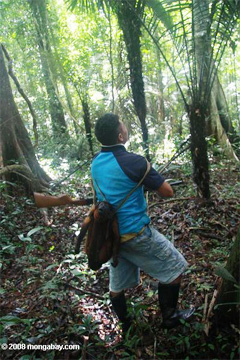Tropical biodiversity on “a trajectory toward disaster”
Tropical biodiversity on “a trajectory toward disaster”
mongabay.com
June 26, 2008
Despite recent debate over the extent of regenerating secondary forest cover, the effectiveness of protected areas and tropical extinctions protections, global biodiversity remains under great threat, warn scientists writing in the journal Frontiers in Ecology and the Environment.
Reviewing the current state of knowledge about tropical diversity and the looming continuing degradation of ecosystems, Corey Bradshaw and colleagues conclude “we are already squarely in the midst of a tropical biodiversity tragedy and on a trajectory toward disaster.” They urge adoption of the precautionary principle when it comes to making conservation decisions.
“The continued disappearance of habitat, soaring human population, and loss of vital ecosystem services demand immediate action,” the authors write. “the recent technical debate about likely extinctions masks the real issue — that, to prevent further loss of irreplaceable tropical biodiversity, we must err on the side of caution. We need to avoid inadvertently supporting political agendas that assume low future extinction rates, because this will result in further destruction of tropical biodiversity.”

Bradshaw and colleagues cited research showing that some 15 million hectares of rainforest were destroyed on an annual basis during the 1990s. |
Bradshaw and colleagues note that while more than 60 percent of known biodiversity is found in the tropics, these regions face an onslaught of threats, including high population growth, poverty, poor governance and corruption, and “unprecedented” rates of habitat loss. Degradation and destruction of these ecosystems not only put biodiversity at risk but threatens human well-being.
“This is not just a tragedy for tropical biodiversity, this is a crisis that will directly affect human livelihoods,” said Bradshaw, Associate Professor at the University of Adelaide’s School of Earth and Environmental Sciences in Australia. “This is not just about losing tiny species found at the base of big trees in a rain forest few people will ever see, this is about a complete change in ecosystem services that directly benefit human life.”

Market hunting is leaving some forests “empty” of key seed dispersers. |
“The majority of the world’s population live in the tropics and what is at stake is the survival of species that pollinate most of the world’s food crops, purify our water systems, attenuate severe flood risk, sequester carbon… and modify climate.”
Bradshaw and colleagues argue that valuing ecosystems for the services they provide will be a critical step to protecting them for the benefit of future generations. Already groups ranging from hedge funds the governments and indigenous groups are looking at ways — including the carbon market — to capitalize on the value of tropical habitats as living entities.
“We need to start valuing forests for all the services they provide, and richer nations should be investing in the maintenance of tropical habitats,” said Bradshaw, adding that improvements in governance would facilitate better management of resources.
“The greatest long-term improvements can be made in governance of tropical diversity resources and good governance will only come from strong multi-lateral policy. We need international pressure to ensure appropriate monitoring and accounting systems are in place,” Bradshaw concluded.
Corey JA Bradshaw, Navjot S Sodhi, and Barry W Brook (2008). Tropical turmoil: a biodiversity tragedy in progress. Frontiers in Ecology and the Environment 2009: 7, doi:10.1890/070193
Related articles
Rainforest species particularly vulnerable to global warming June 8, 2008
Tropical species may be particularly vulnerable to global warming due to their limited ability to adjust to high temperatures, warn scientists writing in the journal Science. Joshua Tewksbury of the University of Washington and colleagues say that cold-blooded tropical animals — including insects, fish, reptiles and amphibians — are especially vulnerable to rising temperatures because they are physiologically specialized with respect to temperature, have limited abilities to acclimatize to new temperatures, and live in places that are already among the warmest on the planet. The authors argue that slight rises in overall global temperature could lead to “steep declines in thermal performance and Darwinian fitness”.
An Interview with Dr. Peter Raven, director of the Missouri Botanical Garden:
Biodiversity extinction crisis looms says renowned biologist March 12, 2007
Few people know more about extinction than Dr. Peter Raven, director of the Missouri Botanical Garden. He is the author of hundreds of scientific papers and books, and has an encyclopedic list of achievements and accolades from a lifetime of biological research. These make him one of the world’s preeminent biodiversity experts. He is also extremely worried about the present biodiversity crisis, one that has been termed the sixth great extinction, following the earlier events caused variously by catastrophic climate change, extraterrestrial collisions, atmospheric poisoning, and hyperactive volcanism. Unlike these older episodes, the current extinction event is one of our own making, fueled mainly by habitat destruction and exploitation of certain species. Further, as Raven points out, because the planet has more species now than at any time in the past, a mass extinction today could well involve more species than ever before.
Just how bad is the biodiversity extinction crisis?
A debate erupts in the halls of conservation science February 6, 2007
In recent years, scientists have warned of a looming biodiversity extinction crisis, one that will rival or exceed the five historic mass extinctions that occurred millions of years ago. Unlike these past extinctions, which were variously the result of catastrophic climate change, extraterrestrial collisions, atmospheric poisoning, and hyperactive volcanism, the current extinction event is one of our own making, fueled mainly by habitat destruction and, to a lesser extent, over-exploitation of certain species. While few scientists doubt species extinction is occurring, the degree to which it will occur in the future has long been subject of debate in conservation literature. Looking solely at species loss resulting from tropical deforestation, some researchers have forecast extinction rates as high as 75 percent.














